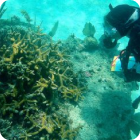
By: Kyle Grammatica
Wekiwa Springs State Park is home to cool, clear waters and vibrant tropical hammocks. The park contains miles of trails, a variety of campsites, incredible paddling opportunities, and of course, swimming! Wekiwa Springs is 72°F year-round, making in a perfect place to cool down during the summer. It is one of the most popular eco-tourism spots in central Florida.
History
Wekiwa Springs was discovered in the 1860s by modern Americans but the area was inhabited by Native American tribes, like the Seminole Tribe, before then. In fact, the name Wekiwa comes from the Creek word for “spring of water.”
In the 1890s a hotel and bathhouse complex was established at Wekiwa Springs (then called Clay Springs) and the area became the first tourist attraction in central Florida, and potentially the whole state. To attract northerners and increase tourism, the spring was said to have medicinal powers that could cure a variety of health problems. Today, the old bathhouse and hotel are no longer standing, but Wekiwa springs still attracts visitors from around the world. In 1941 the Apopka Sportsman Club bought the land that is now Wekiwa Springs State Park. They used the land for hunting and fishing until 1969, when they sold it to the state of Florida. The Sportsman Club had built several hunting cabins on the land, most of which no longer exist. The sole remaining cabin is now used as a ranger residence. The locations of the other cabins are now used as primitive camping sites.
Wekiwa Springs State Park is home to The Florida Park Service Ranger Academy, which trains new park rangers. The first Ranger Academy was held at O’Leno State Park in 1972, but in 1977 it was moved to Wekiwa Springs, where it has been held ever since.
Ocala National Forest
Ocala National Forest was proclaimed a national forest in 1908 by President Theodore Roosevelt. It contains approximately 387,000 acres and is home to four wilderness areas. It is the southernmost forest in the continental United States and protects the world’s largest contiguous sand pine scrub forest. Although the forest contains dry scrub ridges, it’s also home to over 600 lakes, rivers, and springs. Visitors can enjoy a variety of recreational activities, including camping, fishing, horseback riding, and four-wheeling.
History
The Ocala National Forest has been home to a variety of Native American tribes over the years from Paleo-Indians to the Seminole Tribe. In the late 1800s and early 1900s the land was used for turpentine and timber operations. Later in the 1930s, the Civilian Conservation Corps (CCC) began operating in the area. The CCC was one of the New Deal programs created to give the unemployed work. They built many of the long-lasting structures found in our national and state parks and national forests. In Ocala National Forest, they built cabins, monuments, swimming areas, and more. Within Ocala National Forest, many buildings created by the Civilian Conservation Corps are still standing, including Doe Lake Dining Hall and Sweetwater Cabin.
We hope you get to visit Wekiwa Springs State Park and Ocala National Forest soon!











